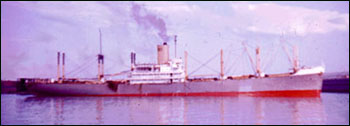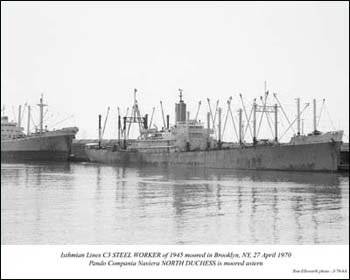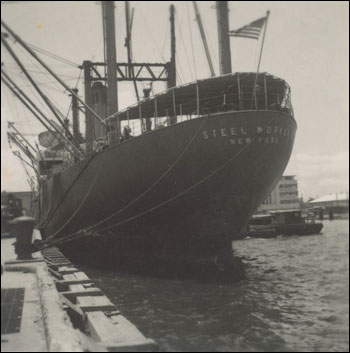| |
| Gross Tonnage: | 7,849 | Net: | 4,653 |
| Dimensions: | 492' 0" x 69' 7" x 29' 5" | MC Type: | C3-S-A2 |
| |
| Builder: | Ingalls Shipbuilding Corp.
Pascagoula, MS | Hull #
USMC Hull #
Date of Build:
Delivered: | 430
1804
1945
6/30/45 |
| Engines: | 2 Steam Turbines DR Geared to Single Screwed Shaft | Engine Builder: | Westinghouse Electric & Mfg. Co.
Pittsburgh, PA |
| Navigation: | DF, ESD, GC, RDR, RT | Decks, etc.: | 2 Decks & Open Shelter Deck |
| Began Isthmian Service: | 1947 | Ended Isthmian Service: | 1971 |
----------------------------------- Vessel History ----------------------------------- |
Date | Vessel
# | Vessel
Name | Vessel
Owner | Call Ltrs | Home
Port | Flag |
1945 | 247834 | Sea Triton | US War Shipping Administration | ANPN | New Orleans | USWB |
1946 | 247834 | Sea Triton | US Maritime Commission | ANPN | New Orleans | US |
1947 | 247834 | Steel Worker | Isthmian Lines, Inc.
New York | KRRN | New York | US |
Events:
8/14/44: Keel laid.
1/26/45: Launched, sponsored by Mrs. John Watts, wife of the Mayor of Pascagoula.
6/30/45: Delivered.
1946: U.S. Maritime Commission.
2/48: Propeller hit buoy; repair propeller and renew shaft at a cost of $13,234.
3/4/48: Collision with barges damaging plates and sheathing; repair cost $4,970.
11/48: Heavy weather damage to plates, keelsons, floors and intercostals; repair cost $14,360.
6/5/51: At Saigon, voyage Baltimore for Singapore, struck by SS FALAISE, Calais for Haiphong, coming alongside; plate and rail damage to STEEL WORKER.
7/24/51: While leaving Cochin, tow wire fouled propeller; diver removed tow wire and found no damage.
4/11/54: Hit dock wall while being worked in to Alexandra Lock, Bombay, resulting in plate damage. Sailing today for New York. Reported 2 plates and 4 frames on port side in way of #2 Tween Deck deeply indented.
5/17/54: Collision with tug BARTOW.
5/23/55: From collision 5/17/54, recondition propeller, install spare propeller, draw tailshaft for exam, renew rope guard, together with sundry damages; repairs and drydocking at New York.
10/25/56: Damage sustained in consequence of backing into a wooden camel while berthing in Alexandria dock Bombay.
3/20/57: At Djibouti on voyage Khorramshahr for New York, vessel was surveyed. Of the 2 oil feed pumps to the turbine gears, one was defective and the other had been in use for a considerable time and could not be guaranteed to function satisfactorily in view of the fact that one the vessel left Djibouti, her next port of call would be New York. It was recommended that the defective pump be disassembled and that parts requiring replacement be sent by plane from New York to Durban or Capetown and the vessel then proceed to the selected port and repairs be effected before the voyage to New York is commenced. A boiler tube was also found to be leaky and repairs are in the course of being effected.
3/21/57: STEEL WORKER left Djibouti for the United States.
3/29/57: Arrived Durban and proceeded the same day.
1/7/58: From damage 10/25/56 at Bombay, tailshaft draw for examination, recondition, spare tailshaft install, stern bearings rebore, together with sundry damages and removals; repairs at Baltimore.
1/16/58: Voyage Baltimore for Penag, while shifting berth and being assisted by tug SEA FOX, collided with steel barge GENERAL PETROLEUM CORPORTATION BARGE NO. 3 and wooden motor tug RUTH FREESE moored to wharf at Oakland, CA in dense fog. Damage to STEEL WORKER and SEA FOX negligible. Barge's hull pushed in above waterline port side amidships and port stern corner. RUTH FREESE is leaking slightly but still in service.
1/20/58: From collision 1/16/58, barge surveyed on behalf of STEEL WORKER, which made contact with port side amidships, causing indents to shell and deck plating with minor indent on starboard side in way of wharf. SEA FOX allegedly struck port stern corner of barge causing similar damage. RUTH FREESE reported slightly leaking but operable pending early drydocking. Extensive damage to wharf timbers and pilings, which had not been used for cargo purposes for many years on account of very dilapidated condition; surveying without prejudice on behalf of STEEL WORKER, which apparently was undamaged.
6/8/63: Struck Municipal Pier No. 38 South at Philadelphia.
11/18/63: From damage alleged sustained 6/8/63 in consequence of striking pier at Philadelphia: Two shell plates renew and one partially renew, deck plating and internals straighten and partially renew, together with sundry damages and removals. Repairs completed at Houston.
2/1/64: Grounded in Houston Ship Channel while proceeding from Baytown to New Orleans.
1/10/65: Stranded at Belawan.
3/17/65: From New York: From damage alleged sustained 2/1/64 in consequence of grounding in Houston Ship Channel: Forward bottom shell four plates renew, three partially renew and one fair, internals further examine at time of repairs, double bottom oil fuel tanks clean and gas-free, together with sundry damages and removals; repairs deferred. From damage alleged sustained 1/10/65 on voyage Manila for Baltimore in consequence of stranding while at Belawan: Propeller remove and recondition, tailshaft draw for examination and Magnaflux test, stern bearing rewood, spare propeller fit, rudder disconnect and remove to shop, fractures in frame cut out and weld, three panel plates renew, three fairwater plates renew, three pintles remachine, three micarta pintle bushes renew, stern frame fracture cut out and weld, together with sundry damages and removals; repairs completed.
4/4/66: From Baltimore: Steamer STEEL WORKER undergoing repairs at Maryland Shipbuilding & Drydock Co., Fairfield, Baltimore, had fire in No. 1 upper 'tween deck on port side this morning: considerable damage to ship and cargo. Fire Dept. still on scene. Fire-fighters were forced to use gas masks to get at the blaze in the No. 1 hold forward, where general cargo, including a large number of Japanese tennis shoes and toys, was stored. Fire-fighters said that the fire was apparently started by workmen with an acetylene torch.
4/7/66: STEEL WORKER surveyed without prejudice in respect of fire on 4/4/66 during burning operation on trunk plating No. 1 hold. We found three port side shell plates renew, three shell frames renew, upper 'tween deck plating partially renew, lower 'tween deck after bulkhead partially renew, escape trunk plating partially renew, together with sundry damages and removals. Repairs being carried out.
4/14/66: STEEL WORKER left Baltimore for Subic Bay.
4/19/66: From New York: Steamer STEEL WORKER, damage alleged sustained 4/4/66 in consequence of fire in No. 1 lower 'tween deck while vessel was under repair at Baltimore: Port side three shell plates renew, three shell frames renew, upper 'tween deck plating partially renew, lower 'tween deck after bulkhead partially renew and escape trunk plating partially renew, together with sundry damages and removals. Repairs carried out.
6/30/66: From New York: Steamer STEEL WORKER: Damage alleged sustained in consequence of grounding, time and place unknown: Bottom shell plating four plates to be cropped and partially renewed, minor repairs to internal floors, etc., two double bottom tanks to be cleaned and made gas-free, with necessary testing and painting; necessary drydocking. Damage alleged sustained to starboard side plating in consequence of striking a dock, time and place unknown: Starboard shell plating four plates to be renewed and four to be faired in place, 14 shell frames to partially renew and two bulkheads partially renew, together with sundry repairs, staging, testing and painting. Removal and replacement of refrigerator insulation in way of repairs. Repairs completed afloat. From damage alleged sustained 2/1/64, in consequence of grounding in the Houston Ship Channel: Bottom shell plating one keel plate to be renewed and three crop and partially renew, moderate repairs to internal floors, etc., necessary testing and painting; necessary drydocking. Repairs completed.
12/17/67: Steamer STEEL WORKER damaged, while lying at anchor at Qui Nhon, in consequence of collision with barge HB9.
2/2/68: From San Francisco: From damage sustained 12/17/67 from collision with barge: Two shell plates crop and renew, one heat and fair and two to be further surveyed, frames and shell frames straighten and partially renew, together with sundry damages and removalsl repairs deferred.
11/19/70: From Calcutta: Emergency declaration declared by Port Commissioners and approved by government, means striking stevedores will be suspended if they refuse to load or unload specified ships.
11/21/70: From Calcutta: Due to port situation, Steamer STEEL WORKER diverted to Madras.
"After obtaining my Second Mate's License, I began sailing for Isthmian Lines, a wholly owned subsidiary of States Marine Lines, in 1969. During four years of massive U.S. Agency for International Development (USAID) shipments, we carried food supplies, like wheat to India. Return cargoes from Chittagong and Chalna were Hessian cloth for carpet backing, in three foot wide rolls twelve - fourteen feet long, tea, cashews and India manufactured clothes. Isthmian's liner service was ending because their ships, like my SS Steel Worker and Steel Maker, were over twenty years old. Using worldwide averages, insurers and shipper wouldn't bother with ships over twenty five years old because of the likelihood of accidents or breakdowns. Some counties, for example Indonesia and Eqypt, legislated against old ships using their ports for safety reasons. In the absence of return cargoes in the early 1970's Isthmian relied on military cargoes to Vietnam and U.S. Agency for Internal Development (USAID) shipments of wheat and foodstuffs to India. U.S. law dictated that a certain percentage of AID cargoes move in U.S. ships. Old ships carried AID cargoes, which the consignees had to accept, but returned empty because the shippers would not use them. After discharge in India in 1971, we were shocked when the SS Steel Worker was ordered to a Taiwan scrap yard. She was a twenty six year old C3 cargo ship, but in good condition after recent repairs in Singapore. At 'Full Astern' we ran the ship onto a bank, until the screw wouldn't turn any more, put out two lines astern, and shut down the power plant. Ships next to us were being cut with torches into ten foot square chunks, starting on the superstructure and proceeding down to the waterline. They rose in the water, as they became lighter. When only the double bottoms remained, a tractor pulled it onto the beach for the final cuts. Later, the Taiwanese learned the value of accessories, like clocks and wooden steering wheels, and made certain that the U.S. crews did not remove them. Scrap yards in Taiwan closed because the space was needed for containerized cargoes. Scrapping is now done in the People's Republic of China, Thailand and India. I became Chief Mate on an old C-3 as Isthmian was selling off their ships. After ten months aboard, I signed on for one more trip to get the required twelve months sea time as Chief Mate to sit for my Master's License. The trip turned out to be six and a half month's long. We loaded general cargo and AID cargo at U.S. East Coast and Gulf ports for India. With no return cargo, we continued to Vietnam and loaded damaged military vehicles for repair in Taiwan. About 1972, after discharging wheat in India, we proceeded to Taiwan, where we loaded AID fertilizer for Surabaja, Indonesia. To cross the bar at the entrance to Surabaja, just before high water, the ship proceeds at "Full Ahead" and stops the engine as she hits the bar to avoid damage to the propeller. Momentum propels the ship through soft mud in a few minutes. As Chief Mate, I ordered rough cleaning of the holds because the charterer had allowed only $250 for cleaning. By the time we returned to Houston, wheat had sprouted in the fertilizer residue and had to be cleaned out at the U.S. labor rate of $250 per hour per hold. We began a shuttle run from either Keelung or Kaohsiung, Taiwan to Surabaja, Indonesia with AID cargoes of fertilizer. ... After the unexpected scrapping of the Steel Worker in Taiwan in 1971, we all had a lot of luggage. I had been on the ship for three years and had new, large stereo speakers. Some of the crew had been aboard for twenty years. The Captain and his wife had their golf clubs. He insisted that Isthmian ship our personal effects back to the U.S. on the same plane with us. We all had to spend two nights in a Kaohsiung hotel. On check-in, all the local whores greeted us. The next morning in the hotel lobby, the Captain, a very pleasant man, gave the crew a draw against wages. He said, 'I never thought I'd be giving out a draw in a whore house.' The girls discreetly stayed away while the Captain was giving out the money." - Capt. Gerald V. Smeenk
| Disposition Date | Comments |
| 1971 | Sold to Taiwan Shipbreakers, having left Calcutta 4/24/71, arriving at Kaohsiung prior to 5/12/71. Scrapped 5/71 Kaohsiung. Reported 7/71: Sold to the Republic of China (Taiwan) for Scrapping. |
|



